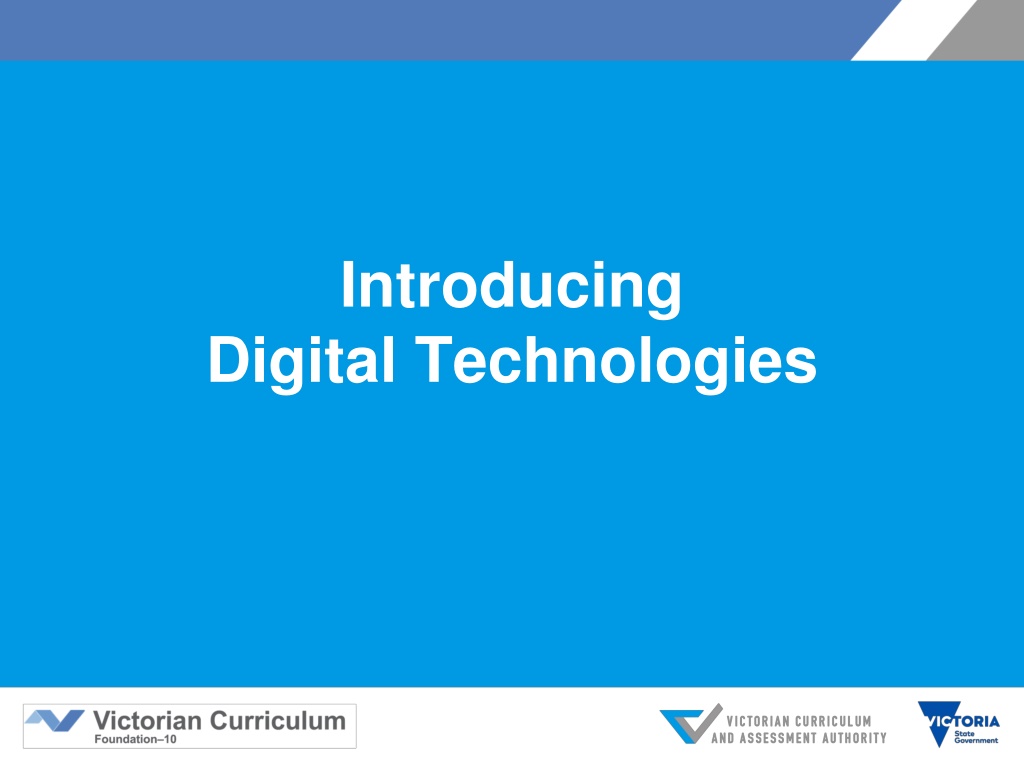
Empowering Students with Digital Technologies Curriculum
Explore the Victorian Curriculum F-10, a framework that aims to equip students with skills to design innovative digital solutions, use computational thinking, apply systems thinking, and adhere to ethical practices. The curriculum focuses on Digital Systems, Data and Information, and Creating Digital Solutions, with achievement standards set at various levels. Key messages emphasize design thinking, systems thinking, and computational thinking as essential skills for students in the digital age.
Uploaded on | 0 Views
Download Presentation

Please find below an Image/Link to download the presentation.
The content on the website is provided AS IS for your information and personal use only. It may not be sold, licensed, or shared on other websites without obtaining consent from the author. Download presentation by click this link. If you encounter any issues during the download, it is possible that the publisher has removed the file from their server.
E N D
Presentation Transcript
Introducing Digital Technologies
Victorian Curriculum F10 Released in September 2015 as a central component of the Education State Provides a stable foundation for the development and implementation of whole-school teaching and learning programs The Victorian Curriculum F 10 incorporates the Australian Curriculum and reflects Victorian priorities and standards http://victoriancurriculum.vcaa.vic.edu.au/
Aims The Digital Technologies curriculum aims to ensure that students can: design, create, manage and evaluate sustainable and innovative digital solutions to meet and redefine current and future needs use computational thinking and the key concepts of abstraction; data collection, representation and interpretation; specification, algorithms and development to create digital solutions apply systems thinking to monitor, analyse, predict and shape the interactions within and between information systems and the impact of these systems on individuals, societies, economies and environments confidently use digital systems to efficiently and effectively automate the transformation of data into information and to creatively communicate ideas in a range of settings apply protocols and legal practices that support safe, ethical and respectful communications and collaboration with known and unknown audiences.
Structure Strands Digital Systems Data and Information Creating Digital Solutions Achievement standards The first achievement standard at Foundation Level 2 and then at Levels 4, 6, 8 and 10. A Towards Foundation curriculum for students with disabilities and additional learning needs is provided in this learning area.
Key messages Focus of different types of thinking Design thinking Use of strategies for understanding design needs and opportunities, for example generating ideas for further development, evaluating ideas based on criteria and conceiving opportunities for new solutions Systems thinking Seeing connections between solutions, systems and society, identifying components of systems and identifying intended and unintended outputs of a system Computational thinking Includes modelling aspects of solutions, sequencing steps and decisions (algorithms) and deconstructing problems into their component parts
Key messages Underpinning the learning is a set of key concepts (outlined below) that establish a way of thinking about problems, opportunities and information systems and provide a framework for knowledge and practice Key concepts: Abstraction Data collection, representation and interpretation Specification, algorithms and development Digital systems Interactions and impacts
Key messages Digital Technologies is a new curriculum Computational thinking is the main focus of this curriculum. Students will develop problem solving skills when creating digital solutions Students will learn various programming languages (coding) to purpose-design digital solutions to solve specific problems Teachers and students need to learn the terminology in the curriculum. It provides students with the vocabulary to describe their learning and explain digital systems
Key messages Around 50 per cent of the curriculum can be taught without the use of a computer. We refer to this as unplugged learning Aspects of the curriculum can be integrated with other curriculum areas, particularly Mathematics, Science, Geography and the Arts As this is a new curriculum, older students may need to begin their learning at lower levels. This will provide the necessary scaffolding and ultimately support progression of learning Whole-school planning is essential for schools to determine how and when the curriculum is taught
